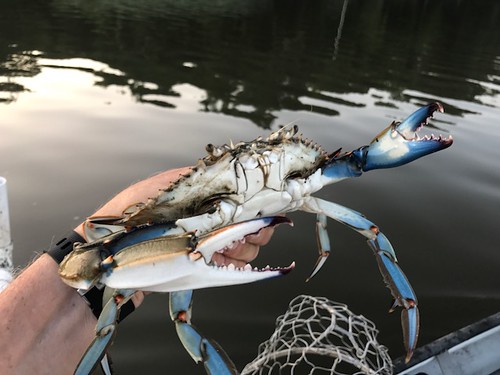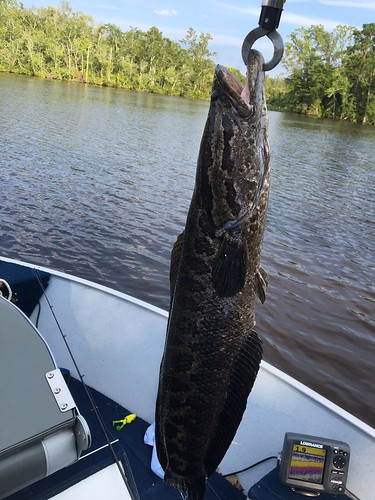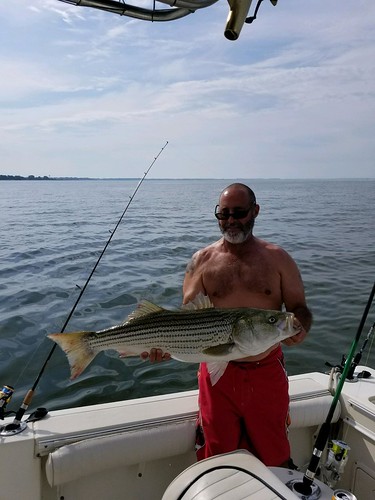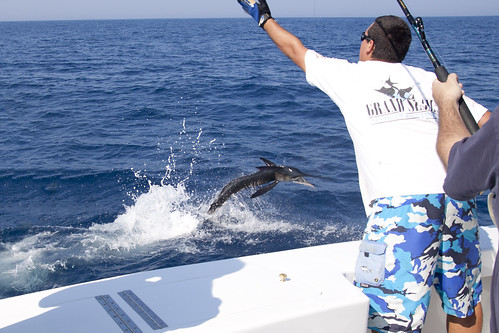Weekly Fishing Report: July 19
 Our friends at Eyes On The Bay have always had valuable information about bay conditions that help fishermen, ranging from information on water quality to satellite imagery. They now have added a wonderful new site called Click Before You Cast which uses a simple to follow, step-by-step process to help anglers identify the best places to fish based on the water quality and habitat preferences of the fish they are trying to catch. Maryland anglers can now eliminate unproductive waters, save fuel, and increase chances of fishing success. All serious anglers owe it to themselves to check out this valuable information. We have placed a permanent link for Click Before You Cast on the Fishing Report Links. Please check it out and let us know what you think! There is a comment section at the bottom of the website where you can provide feedback.
Our friends at Eyes On The Bay have always had valuable information about bay conditions that help fishermen, ranging from information on water quality to satellite imagery. They now have added a wonderful new site called Click Before You Cast which uses a simple to follow, step-by-step process to help anglers identify the best places to fish based on the water quality and habitat preferences of the fish they are trying to catch. Maryland anglers can now eliminate unproductive waters, save fuel, and increase chances of fishing success. All serious anglers owe it to themselves to check out this valuable information. We have placed a permanent link for Click Before You Cast on the Fishing Report Links. Please check it out and let us know what you think! There is a comment section at the bottom of the website where you can provide feedback.
Last Friday I had the opportunity to head out to Clear Spring to spend time with some of the outdoor writers that belong to the Mason Dixon Outdoor Writers Association. One of the activities that was presented was kayaking on the upper Potomac, which was grand fun. Of course there was payment due late Friday night as I sat in a long traffic backup trying to get back across the Bay Bridge. As I sat there, my mind drifted off to memories of small boats. I’m sure that you all also have memories of small boats of your own, whether it was your first time out as a little kid or when you actually owned your first small boat. We should all cherish those memories. I’ve had many boats, and still do, to which my wife thinks I’m trying to start my own boat yard. My first boat, if we can call it that, was half of a belly tank from a WWII P-47 fighter airplane, which my neighbor on the next farm over cut in half. The farmer’s son got half and I got half. At the age of seven it opened up an entirely different world to me as I explored the nearby back waters, trying to paddle this thing on my knees, which wiggled as I paddled because it had no keel. There have been many, many more boats in my lifetime but I will always have a warm spot in my heart for that silly little aluminum aircraft belly tank. Youngsters will always remember their first outing or their first small boat when they became the captain of their own ship. Make the effort to introduce a youngster to small boats, it will open up a new world to them and the repayment will be beyond measure.
At the very top of the bay there continues to be some striped bass action in the Conowingo Dam pool and the boulder strewn areas a little farther down the river. The dam has been generating power most of the day so there is quite a bit of water moving through the dam. Those casting and drifting live eels have been doing well and fishing topwater lures early in the morning has also been accounting for some fish. There is also a limited amount of topwater action along the outside edges of the Susquehanna Flats before sunrise.
In the upper bay there has been some striped bass action around Pooles Island for those drifting live eels along channel edges and some trolling success for those trolling bucktails dressed with twister tails close to the bottom along channel edges.
The action really picks up from Swan Point south to the Triple Buoys/Love Point area and Podickory Point. Fleets of boats have been setting up on the steep channel edge at these locations and have been chumming with good success for a couple of weeks now. Most are slowly maneuvering along the edges while watching depth finders for suspended fish and then begin to chum on top of them while anchoring up.
A good portion of the fish that come up through the water column in chum slicks have been two and three year old fish so throwbacks can be an issue. If you are using J style hooks, deep hooking will occur and once that hook pulls forward in a downward position, the hook will puncture sensitive organs. Even though they swim away, death can occur in several minutes or hours later. Although many will say circle hooks are “just no fun” and “I like to set the hook” circle hooks are the answer to prevent deep hooking and something to consider when chumming.
The larger striped bass often tend to hold back to where the chum begins to settle on the bottom. Baits that are allowed to lay on the bottom at the back of the chum slick often catch the larger fish. Channel catfish will also be found in this same area. Water temperatures in the upper bay are in the low 80fs this week and these warm temperatures will cause large striped bass to stay as close to the bottom as possible where it is cool as long as there is sufficient oxygen to breathe.
The presence of spot in the middle bay area has many transporting live spot to upper bay locations now and live lining in the same areas where others are chumming. This is especially true around the Bay Bridge piers and rock piles as well as the Sewer Pipe and Podickory Point.
In the middle bay region this week there are some striped bass fishing opportunities to be found, especially now that live lining size spot are available in the tidal rivers and creeks. Bloodworms are a precious commodity but the best bait for catching spot. Sometimes if you have a bait board you can mix a few nightcrawlers in with all of the bloodworm juice and fool a few spot with small pieces of nightcrawler infused with bloodworm taste. You can also use synthetic Fish Bites (tough artificial bloodworm baits) to supplement your supply of natural bloodworms. If you slowly cruise near channel edges at some of the traditional locations you may find some suspended fish and then drop live spot in to the school of striped bass. The Diamonds, the Hill, Thomas Point and Hackett’s are a few places worth checking out.

Wynn Poole was jigging for white perch with a half- ounce Stingsilver when he got quite a surprise when this black drum struck his jig.
There continues to be some trolling action along the steeper channel edges of the shipping channel on the western side of the bay from Chesapeake Beach south. Inline weights or planers are needed to get lures down close to the bottom where fish are holding. Bucktails dressed with sassy shads or twistertails are a good bet as are surge tube lures.
White perch fishing in the middle bay region has been very good on some of the hard-bottomed reef areas. There are several head boats running out of Kent Narrows now, fishing near the Eastern Bay and Sandy Point areas. Wild shrimp, peeler crab and bloodworms are the most common baits being used out in the bay. In the creeks and tidal rivers when fishing near docks, piers and similar structure grass shrimp are preferred on a bottom rig or shad dart.
The middle bay region shallow water fishery is now mostly a pre- sun up situation now that water temperatures are in the mid 80s. By the time the sun peeks over the horizon many striped bass are headed for deeper water. Topwater lures are the ticket to this show so you can stay above the grass and be entertained by surface strikes. Speckled trout are becoming a more common addition to this fishery, especially in the Little Choptank and Hooper’s Island area.
The lower bay region is a very exciting place to fish this week with a wide variety of fishing opportunities. Perhaps one of the most exciting developments has been the surge of spot into the region and bottom fishermen are enjoying spectacular fishing for them from Tangier Sound to the lower Potomac. The mouth of the Patuxent and Potomac have been offering the best catches. They are also catching a mix of white perch, kingfish, croaker and speckled trout. Bloodworms are about the only bait to use for spot, but shrimp, peeler crab and squid can work for white perch, trout and croaker. One note on kingfish, at the present time Maryland does not have a minimum size or daily creel limit for kingfish since they have not been very common here in the past. Of course the presence of spot opens up the opportunities for live lining spot in some of the deeper areas where striped bass and cobia can be found.
Chumming for a mix of striped bass and bluefish continues to be good this week at the Buoy 72 area, the Middle Grounds, the lower Potomac near St. Georges Island and Piney Point as well as the rock piles just north of Point Lookout on the bay side. Catches have been very good and the bluefish are a nice eating size. Cobia and inshore sharks are becoming more common chum slick visitors this week, which can make for some drag screaming fun.
Trolling a mix of parachutes, bucktails, small spoons and surge tube lures around the Target Ship and channel edges on both sides of the bay has been a worthwhile endeavor. When trolling on the eastern side of the bay it pays to have at least one large spoon in the spread for some fun catch and release action with the large red drum in the area.
Cobia are becoming more common in the region on the eastern side of the bay and many are now sight casting with large skirted soft plastic jigs or live eels near buoys and the Target Ship. Large red drum area also in the area of the Target Ship and the Mud Leads nearby. Trolling has been the most popular way to fish for them but others have been fortunate enough to find slicks where schools of these large fish have been feeding on the bottom. Jigging can be an effective way to fish for them when this occurs but hang on and tighten that drag!

Jim Livingston sent us this picture of a whopper size crab that we’d all like to see in our collapsible crab traps or coming up on a trot line.
Over on the eastern side of the bay, the fishing for speckled trout from Hooper’s Island south to Pocomoke Sound has been very good. Casting swimbaits like Gulp mullet in white or similar soft plastic jigs has been a popular option. Fishing with peeler crab or soft crab baits on a falling tide is another popular method. A mix of striped bass that are mostly undersized, bluefish, a few puppy drum, kingfish, spot and croaker can also be found in the area.
Recreational crabbing is excellent in the lower bay region’s tidal rivers and creeks this week. Both chicken necks and razor clams are doing well for those using trot lines or collapsible crab traps. Crabbing in the middle bay region has been good with most being able to catch a full bushel per outing. In the upper bay crabbing has been tough with fair to poor catches in most areas.
Before we leave the bay and move to the freshwater and ocean section of the report, check out this article which provides more information on the “Click Before You Cast” website, and how you can use online resources to catch more fish.
Freshwater fishing in the western region of the state has been offering several opportunities. Trout fishing has been good in many of the trout management waters that promote catch and release. Those who know how to “match the hatch” of aquatic insects or have favorite terrestrial flies can enjoy plenty of fun action in these areas that have been set aside for just such activities. To help bolster those opportunities the hatchery program stocked 1,000 rainbow trout into the Youghiogheny River last month. The hatchery program also stocks a lot of fingerling trout in trout management waters that can support trout yearround and several were stocked recently. The Zero Creel Limit section of the North Branch of the Potomac received over 65,000 fingerling rainbow trout and Little Seneca Creek and Gunpowder Falls each received 5,000 fingerling rainbow trout.
The upper Potomac River is running low and clear this week and enticing smallmouth bass will take long casts with lighter lines or better yet fluorocarbon line. Targeting strong current breaks in deeper waters that might be shaded is a good place to fish with topwater lures.
At Deep Creek Lake a mix of smallmouth and largemouth bass can be found lounging near floating docks. Casting whacky rigged stick worms in pumpkin green colors have been one of the better ways to entice them to pick up. That is usually what happens, it is a subtle pick up and not a crashing strike. Most fish have gone deep for the summer but pickerel can be found in the back coves and largemouth bass in some of the thicker grassy areas of the coves.

Herb Floyd was fishing a chatterbait when he caught this northern snakehead while fishing on the Chicawicomico.
Lakes, ponds, tidal waters and reservoirs offer good fishing for largemouth bass this week if one follows the bass’s summer mode of behavior mantra. Shallow areas at night, cool deeper and shaded waters during the day. Frogs and buzzbaits are a lot of fun when worked in the shallower areas during the early morning hours where the largemouth bass have been feeding all night. As the sun hovers in the sky these fish will be looking for cool shade. They will find it in deeper water, under docks, fallen tree tops, overhanging brush and sunken wood. When these fish are in a sulking, hanging out type of mood, they just can’t seem to pass up a twitching stick worm that is whacky rigged. Crappie can be found schooled up deep around bridge piers in the larger reservoirs and marina docks in tidal waters. Large land locked white perch in reservoirs such as Loch Raven can be caught by slow trolling with nightcrawlers in a worm harness.
Northern snakeheads will provide shallow water action in the lower Potomac River’s shallow areas and buzzbaits and frogs tend to be two of the better baits to use. The lower Eastern Shore also has a lot of northern snakeheads in the tidal creeks and can be found in some fairly poor water conditions. Herb Floyd was fishing a chatterbait when he caught this northern snakehead while fishing on the Chicawicomico.
Channel catfish are very common in the tidal rivers of the bay and can be caught on most any kind of cut bait or chicken livers. The lower Potomac from the Wilson Bridge to the Route 301 Bridge is full of blue catfish and one can catch them until your arms are about to fall off. They are perhaps our finest eating catfish.
Over to the east at the Ocean City area, the middle of the summer season is upon this resort area and those that come to fish have been not been disappointed on the whole. There is good fishing for a mix of kingfish, flounder, blowfish and bluefish in the surf. Due to warming water temperatures and bright sun, the early mornings and late evenings often present the best fishing opportunities.
At the inlet and Route 50 Bridge area there has been good fishing for sheepshead for those using sand fleas. Flounder are present and recently there has been an influx of bluefish which anglers are enjoying catching. In the back bay channels flounder are the most popular target. The classic squid and or minnow combination is a popular choice but often the target of small pesky sea bass and sea robins. Gulp baits on a jig head are a good way to target larger flounder but they can be few and far between at times.
The fishing for sea bass and flounder at the inshore wreck and reef sites can be good when there is not sub-bottom profiling going on. Apparently this acoustic survey works drives fish away or makes them miserable enough not to feed. Those heading farther offshore near the canyons have been enjoying excellent catches of sea bass and tilefish.
Chunking for yellowfin and Bluefin tuna at some of the 30 Fathom Line hot spots has been good at times but not always predictable. At times catches have been good at the hot dog, sausages, hambone and some have been venturing out to the inside edge of Massey’s Canyon. Those who are trolling are catching a mix of yellowfin and Bluefin tuna, dolphin, wahoo as well as white marlin and blue marlin from the 30 Fathom Line out to the Canyons.
“Fishing keeps men boys longer than any other pursuit.” – Zane Grey
 ABOUT THE AUTHOR Keith Lockwood has been writing the Fishing Report since 2003 and has had a long career as a fisheries research biologist since 1973. Over the course of his career he has studied estuarine fishery populations, ocean species, and over a decade long study of bioaccumulation of chemicals in aquatic species in New Jersey. Upon moving to Oxford on the eastern shore of Maryland; research endeavors focused on a variety of catch and release studies as well as other fisheries related research at the Cooperative Oxford Laboratory. Education and outreach to the fishing public has always been an important component to the mission of these studies. Keith is an avid outdoorsman enjoying hunting, fishing, bird dogs, family and life on the eastern shore of Maryland.
ABOUT THE AUTHOR Keith Lockwood has been writing the Fishing Report since 2003 and has had a long career as a fisheries research biologist since 1973. Over the course of his career he has studied estuarine fishery populations, ocean species, and over a decade long study of bioaccumulation of chemicals in aquatic species in New Jersey. Upon moving to Oxford on the eastern shore of Maryland; research endeavors focused on a variety of catch and release studies as well as other fisheries related research at the Cooperative Oxford Laboratory. Education and outreach to the fishing public has always been an important component to the mission of these studies. Keith is an avid outdoorsman enjoying hunting, fishing, bird dogs, family and life on the eastern shore of Maryland.
Want the Weekly Fishing Report sent right to your inbox? Click here to sign up!


